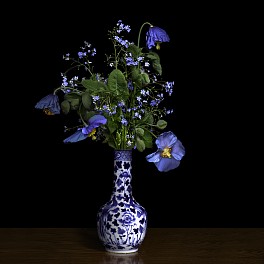BIOGRAPHY

Notes on Looking at Flowers: visual pleasure and the vernacular of beauty in T.M. Glass’ photographs
Like the chambers of a nautilus shell, when looking at T.M. Glass’ oeuvre both my eye and mind spiral in and out of focus. These notes begin to survey the visual pleasure induced by Glass’ work as well as what it means to look at looking, closely.
To begin, I concentrate on process. Glass’ images are persuasive studies of process turned beauty: flowers are cultivated, selected, cut, positioned, photographed, painted in the digital realm, and printed at tremendous resolution—a painstaking process using cutting-edge technology. This process, which Glass develops carefully over much time, describes the images' power: each bloom is rendered unique, complex, exquisite, emotional; both natural and supernatural; both still and alive.
Temporarily lost in a consideration of the immensity of data contained within an image comprised of one hundred million pixels, I zoom out and begin to decipher structural. Employing radial symmetry, Glass’ compositions reflect universal principals of aesthetics relative to the ‘Golden Mean’—a philosophy that understands beauty to contain three essential ingredients: symmetry, proportion, and harmony. Described mathematically as the Fibonacci sequence or fractal geometry, the ratio portrays a simple recurrence pattern of relation in which each number equals the sum of the two numbers before it (0,1,1,2,3,5,8,13,21,34,55,89,144).
I am reminded of the fractal when I read Baudelaire’s statement that “The beautiful is always strangely familiar and vaguely surprising.” Herein lies why it is so easy to call flowers beautiful, for what could be more recognizable, more common, pervasive than the prettiness of flowers and yet who can deny the wonder—that special love—of seeing the first snowdrops or crocus after the hard dryness of winter?
It is within the beauty of flowers that I understand the beautiful to be a thing. I fall into a state when I look at the beautiful. A state of pleasure. Art critic Dave Hickey is credited with jumpstarting a conversation on beauty in relation to contemporary art with an in-depth analysis of the political implications of Robert Mapplethorpe’s photography, both botanical and other. In his initial statement on the necessity of beauty, he contends “any theory of images that is not grounded in the pleasure of the beholder begs the question of art’s efficacy and dooms itself to inconsequence!” Pleasure, Hickey believes, is the truest reason for looking. Beauty acknowledges the viewers’ ultimate authority. We do not turn towards beauty because it is good for us; we turn towards beauty because we cannot help ourselves.
I bring to mind my favorite flower, imagining the intimacy of looking at a newly blossomed red poppy. Reflecting upon the special love the eye has for the concave and the convex, how effortlessly, sympathetically, with pleasure, my eye falls into and around the curved shapes of the flower. The shadow of my pupil captures the poppy’s crimson edges that deepen to an inky center, like black silk. My round eyes fall into the concavity of its cup-like shape. I linger on the rarity of its petals, paper-thin. The image floods my mind as if through an act of actual perception. How easy it is to fit a flower into the space of my third eye—the body’s natural space for visualization. As essayist Elaine Scarry affirms, “Flowers can be taken as the representative of the imagination because of the ease of imagining them.” As if we were made for one another. Like the bee and its orchid.
